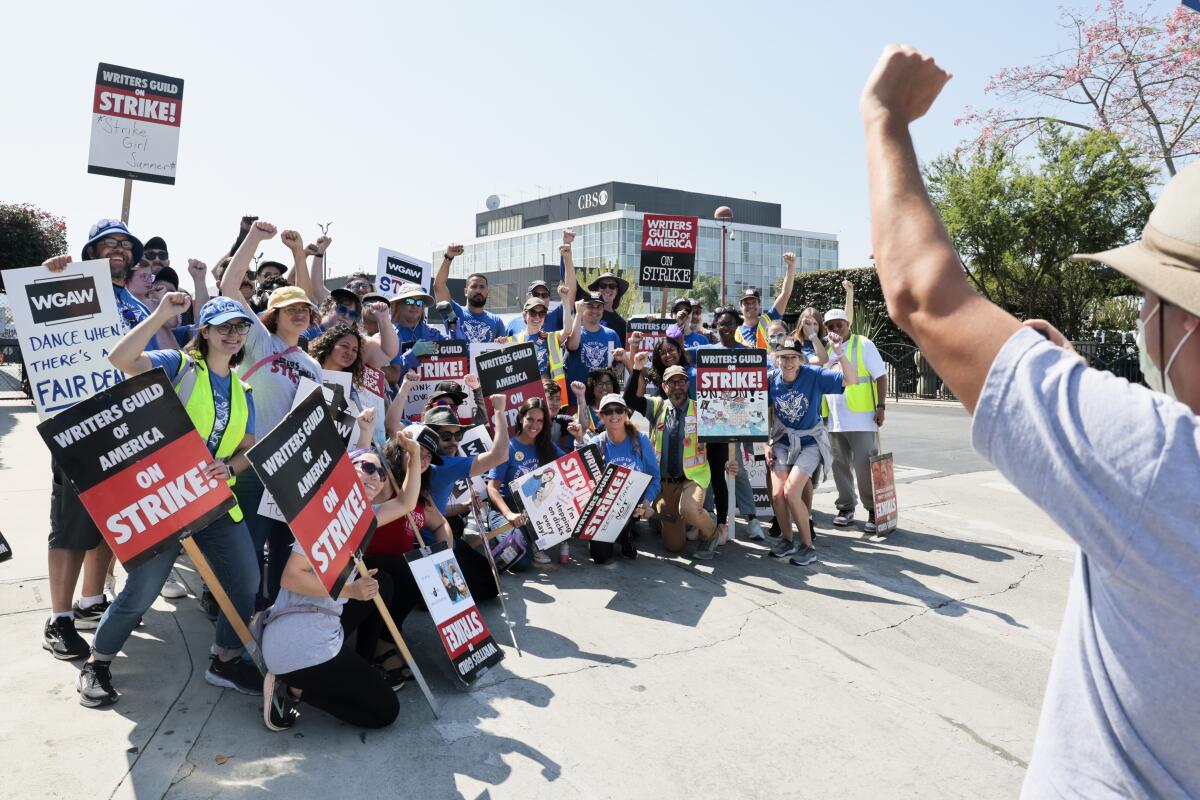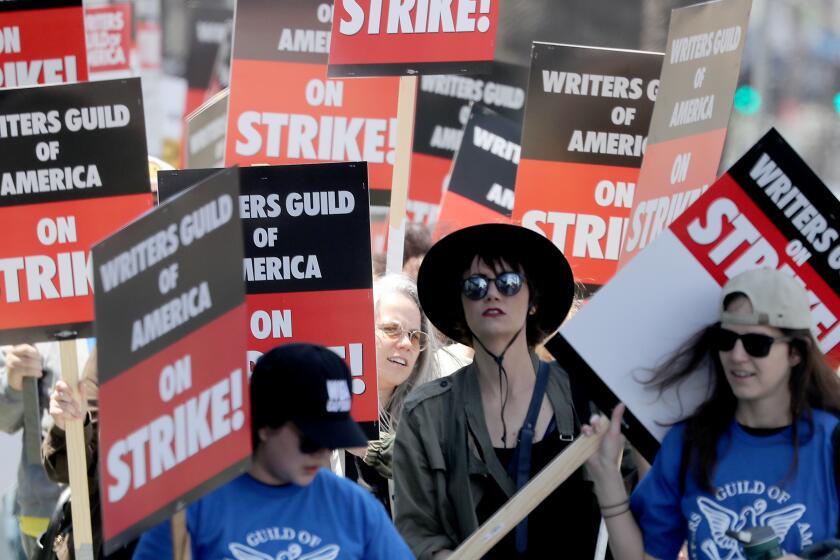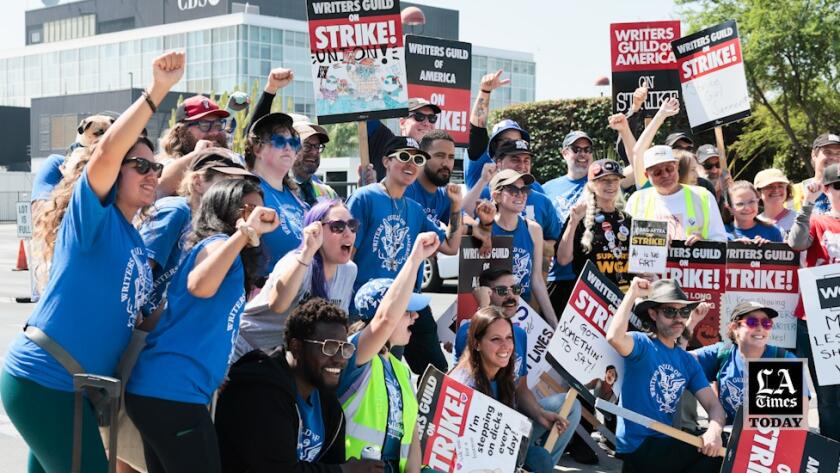Column: Hollywood is ready to go back to work. But Hollywood is never going back to normal

- Share via
Barring any significant and unforeseen pushback from the voting members of the Writers Guild of America, it would seem that the 146-day writers’ strike is at an end.
Sunday night, negotiators for the WGA and the Alliance of Motion Picture and Television Producers came to a tentative agreement on a new three-year contract.
So congratulations to the WGA for standing strong, and congratulations to the AMPTP for finally doing what it should have done five months ago in order to spare workers in the entertainment industry — plus many more in adjacent fields in Los Angeles and other places where television and film production contribute to the local economy — a world of hurt.
Better late than never, I suppose.
With any luck, the studios also will settle quickly and fairly with the still-striking Screen Actors Guild-American Federation of Television and Radio Artists and everyone can get back to work.
I do not say “back to normal” because it is important to remember that there is no going back to “normal” in the entertainment industry these days.

Subscribers get exclusive access to this story
We’re offering L.A. Times subscribers special access to our best journalism. Thank you for your support.
Explore more Subscriber Exclusive content.
The end of the writers’ strike, even if it is coupled with an end to the actors’ strike, should not be seen as “problem solved” by anyone. Both guilds struck to ensure fair treatment of their members, not to fix fractures that were decades in the making.
So celebrate the moment but do not imagine we will be returning to the glory days when “Mad Men” set the template for basic-cable prestige or “Downton Abbey” revitalized PBS. Gone forever are those starry-eyed days when Netflix reinvented bingeing and the small screen suddenly seemed limitless.
The business model of the art form known as television is a mess. Contraction is the name of the game — and that has nothing to do with the strikes or the gains that may be won through them.
So when your streaming fees inevitably go up, or you realize you have to choose between paying extra or watching ads on your previously ad-free platform, do not blame the writers or the actors. They are not the reason a subscription to Peacock costs money, even with ads.
The 2023 writers’ strike is over after the Writers Guild of America and the Alliance of Motion Picture and Television Producers reached a deal.
Thus far, entertainment consumers who do not live for the sight of stars on the Venice or Toronto red carpets have been largely unaffected by the work stoppages. That will change as the five-month absence of writers and (one hopes) three-month absence of actors make themselves felt. When are we going to see the next season of “Hacks,” “Yellowstone” or ”Stranger Things”? Who knows. Those looking forward to “Dune: Part Two,” the “Ghostbusters” sequel or Sony / Marvel’s “Kraven the Hunter” will have to wait until next year.
And the pause will not be over then. Films scheduled for 2024 and 2025 release were hit mid- or pre-production; “Blade,” the next entry in James Cameron’s “Avatar” franchise, the “Dirty Dancing” sequel, “Spider-Man: Beyond the Spider-Verse” and many more have been pushed back at least a year.
But beyond specific shows and movies, any upheaval for television and film viewers will be a continuation of snowballing trends.
In television anyway, less is about to become the new more. Because it must.
In 2015, FX Networks chief and unofficial mayor of television John Landgraf coined the term “peak TV,” claiming that the 408 scripted series on television that year marked a saturation point beyond which the center could not hold.
Though his timing might have been off, he was right about the core issue: Too many new platforms to launch! Too many Emmy races to dominate!
Unfortunately, no one listened. By 2019 there were 532 scripted series; this year there are 599. Trying to keep up makes any normal person feel like Lucy and Ethel shoving chocolates down their shirts in that famous candy factory scene from “I Love Lucy.”
We all stopped trying to keep up long ago. Which is a problem. Does the Marvel universe truly expand if no one is there to watch it?
As the writers and actors have made clear, much of the cost for this eruption of content was borne by them — they, and all the other workers who make television, were expected to produce more for less.
Less money, less staff, in many cases less marketing support and, in the case of streaming, less understanding of what the audience wants and how well the show was doing.
Sign up for This Evening's Big Stories
Catch up on the day with the 7 biggest L.A. Times stories in your inbox every weekday evening.
You may occasionally receive promotional content from the Los Angeles Times.
That has to change. It was always going to. Now, one hopes it will do so with protections for the Hollywood rank and file firmly in place.
Because contraction does not have to be a bad thing if it means fewer shows but greater commitment — to workers and viewers, to marketing and longevity.
We may never return to the 21-episode standard, but you know why “Suits” is so popular on Netflix right now? Because it ran for nine seasons, almost all with 16 episodes. So if you like it, you can watch it for a very long time!
Harder to do with shows whose orders have been cut from 10 to eight to six episodes — and then canceled after three seasons anyway.
A decade after Netflix disrupted the industry with ‘House of Cards,’ Peak TV is in retreat, and in its place is a new era of discontent.
Streamers are also finally learning what broadcast and cable have long known: While it is close to impossible to produce an infinite amount of content and make money, it is absolutely impossible to do so without advertising.
Hence streaming platforms’ recent embrace of the very models they once so mockingly dismissed.
Netflix, Amazon, Hulu et al. still offer portability and viewer control that broadcast and cable cannot, but many streaming series have abandoned the full-season binge model in favor of weekly episodes or a hybrid model. Many now feature advertising (or require an extra fee to avoid it) and rely on cliffhanger finales just like broadcast television.
And yes, sometimes the streamers cancel these shows mid-hang, with the same heartbreaking results as ever. The myth that streaming content lives forever has been shot down too; now even original content vanishes, sometimes before it has even aired.
All of these changes, along with continued speculation about future platform consolidations — what will happen to Hulu when Disney buys out Comcast’s shares? — will continue to yank subscribers and viewers this way and that until new media bears a suspicious resemblance to the old.
Nobody appears to know how to make it work any other way.
Not that this has anything to do with writers and actors demanding contracts that allow them to make a living in their chosen profession. Which you should remember the next time one of the streamers you subscribe to disappoints you, as it surely will.
For months now, the studios have tried to make it seem that the writers and actors were intent on destroying the industry — that the guilds’ demands for a living wage and a clear career path could somehow sink the whole ship.
But we didn’t get here in five months, or even three years. Writers and actors are in the business of creating. Buying and selling, programming and platforming, marketing and analyzing — that’s masterminded by the studio heads.
Which is why they make the big bucks, and never have to strike to get them.
- Share via
Watch L.A. Times Today at 7 p.m. on Spectrum News 1 on Channel 1 or live stream on the Spectrum News App. Palos Verdes Peninsula and Orange County viewers can watch on Cox Systems on channel 99.
More to Read
Sign up for This Evening's Big Stories
Catch up on the day with the 7 biggest L.A. Times stories in your inbox every weekday evening.
You may occasionally receive promotional content from the Los Angeles Times.














